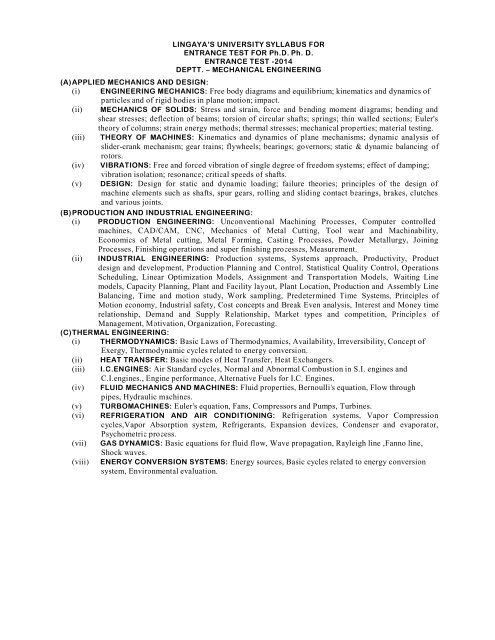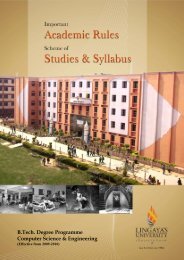1. COMPUTER ARCHITECTURE & ORGANIZATION: Combinational ...
1. COMPUTER ARCHITECTURE & ORGANIZATION: Combinational ...
1. COMPUTER ARCHITECTURE & ORGANIZATION: Combinational ...
You also want an ePaper? Increase the reach of your titles
YUMPU automatically turns print PDFs into web optimized ePapers that Google loves.
LINGAYA’S UNIVERSITY SYLLABUS FORENTRANCE TEST FOR Ph.D. Ph. D.ENTRANCE TEST -2014DEPTT. – MECHANICAL ENGINEERING(A)APPLIED MECHANICS AND DESIGN:(i) ENGINEERING MECHANICS: Free body diagrams and equilibrium; kinematics and dynamics ofparticles and of rigid bodies in plane motion; impact.(ii) MECHANICS OF SOLIDS: Stress and strain, force and bending moment diagrams; bending andshear stresses; deflection of beams; torsion of circular shafts; springs; thin walled sections; Euler'stheory of columns; strain energy methods; thermal stresses; mechanical properties; material testing.(iii) THEORY OF MACHINES: Kinematics and dynamics of plane mechanisms; dynamic analysis ofslider-crank mechanism; gear trains; flywheels; bearings; governors; static & dynamic balancing ofrotors.(iv) VIBRATIONS: Free and forced vibration of single degree of freedom systems; effect of damping;vibration isolation; resonance; critical speeds of shafts.(v) DESIGN: Design for static and dynamic loading; failure theories; principles of the design ofmachine elements such as shafts, spur gears, rolling and sliding contact bearings, brakes, clutchesand various joints.(B)PRODUCTION AND INDUSTRIAL ENGINEERING:(i) PRODUCTION ENGINEERING: Unconventional Machining Processes, Computer controlledmachines, CAD/CAM, CNC, Mechanics of Metal Cutting, Tool wear and Machinability,Economics of Metal cutting, Metal Forming, Casting Processes, Powder Metallurgy, JoiningProcesses, Finishing operations and super finishing processes, Measurement.(ii) INDUSTRIAL ENGINEERING: Production systems, Systems approach, Productivity, Productdesign and development, Production Planning and Control, Statistical Quality Control, OperationsScheduling, Linear Optimization Models, Assignment and Transportation Models, Waiting Linemodels, Capacity Planning, Plant and Facility layout, Plant Location, Production and Assembly LineBalancing, Time and motion study, Work sampling, Predetermined Time Systems, Principles ofMotion economy, Industrial safety, Cost concepts and Break Even analysis, Interest and Money timerelationship, Demand and Supply Relationship, Market types and competition, Principle s ofManagement, Motivation, Organization, Forecasting.(C)THERMAL ENGINEERING:(i) THERMODYNAMICS: Basic Laws of Thermodynamics, Availability, Irreversibility, Concept ofExergy, Thermodynamic cycles related to energy conversion.(ii) HEAT TRANSFER: Basic modes of Heat Transfer, Heat Exchangers.(iii) I.C.ENGINES: Air Standard cycles, Normal and Abnormal Combustion in S.I. engines andC.I.engines., Engine performance, Alternative Fuels for I.C. Engines.(iv) FLUID MECHANICS AND MACHINES: Fluid properties, Bernoulli's equation, Flow throughpipes, Hydraulic machines.(v) TURBOMACHINES: Euler's equation, Fans, Compressors and Pumps, Turbines.(vi) REFRIGERATION AND AIR CONDITIONING: Refrigeration systems, Vapor Compressioncycles,Vapor Absorption system, Refrigerants, Expansion devices, Condenser and evaporator,Psychometric process.(vii) GAS DYNAMICS: Basic equations for fluid flow, Wave propagation, Rayleigh line ,Fanno line,Shock waves.(viii) ENERGY CONVERSION SYSTEMS: Energy sources, Basic cycles related to energy conversionsystem, Environmental evaluation.
















